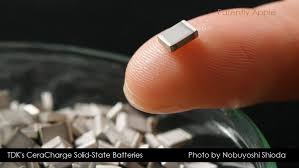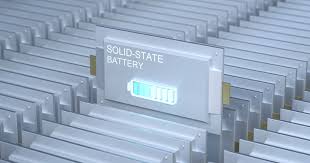
Introduction
Solid-state batteries are an emerging energy storage technology that promises to revolutionize the way we store and use energy. Unlike conventional lithium-ion batteries, which use a liquid or gel electrolyte, solid-state batteries replace the liquid electrolyte with a solid electrolyte. This change offers several potential advantages, such as higher energy density, improved safety, and longer lifespans. As the demand for electric vehicles (EVs), portable electronics, and renewable energy storage increases, solid-state batteries could provide the next major leap in energy storage solutions.
How It Works
A solid-state battery operates similarly to traditional batteries, with a positive electrode (cathode), a negative electrode (anode), and an electrolyte that allows the movement of ions between the two electrodes during charging and discharging. The key difference is in the electrolyte material:
- Solid Electrolyte:
In a solid-state battery, the electrolyte is a solid, often made from materials such as ceramics or polymers, rather than a liquid or gel. This solid electrolyte conducts ions between the anode and cathode during the charge-discharge cycle. - Anode and Cathode:
The anode typically uses lithium metal or other advanced materials, while the cathode is made from lithium or other metal-based compounds. The solid electrolyte enhances the efficiency and stability of the battery, allowing it to handle higher energy densities. - Ions Movement:
When the battery charges, lithium ions move from the cathode to the anode through the solid electrolyte. During discharge, the ions move back from the anode to the cathode, releasing energy in the process.
Potential Benefits

- Higher Energy Density:
Solid-state batteries can store more energy per unit of weight or volume compared to liquid electrolyte-based batteries. This higher energy density could lead to longer-lasting power sources for electric vehicles, portable electronics, and renewable energy storage systems. - Improved Safety:
Traditional lithium-ion batteries are prone to leakage, thermal runaway, and even fires due to the flammable liquid electrolytes they contain. Solid-state batteries eliminate the risk of leakage and are inherently safer, reducing the chances of catastrophic failures. - Longer Lifespan:
Solid-state batteries are expected to have longer lifespans compared to conventional batteries. This is because the solid electrolyte is more stable and less prone to degradation over time, which can extend the overall life cycle of the battery. - Faster Charging:
The improved conductivity of solid electrolytes allows for faster ion movement, potentially enabling solid-state batteries to charge faster than traditional lithium-ion batteries. This could be a game-changer for electric vehicles, which often suffer from long charging times. - Wide Temperature Range:
Solid-state batteries perform well across a broad temperature range, which makes them suitable for extreme environments, such as those found in aerospace applications, electric vehicles, and remote areas.
Why It’s Underrated
Although solid-state batteries have garnered attention in research and development, they remain relatively underrated for several reasons:

- Manufacturing Challenges:
Producing solid-state batteries on a large scale is still technically challenging. The processes involved in fabricating solid electrolytes and ensuring proper contact between the electrodes and electrolytes are more complex than traditional battery manufacturing. - Cost of Production:
Solid-state batteries are currently more expensive to produce compared to lithium-ion batteries, primarily due to the high cost of materials and the manufacturing techniques required. However, as the technology matures and economies of scale are achieved, costs are expected to decrease. - Technology Maturity:
The technology is still in the development phase, with several companies and research institutions working to address the technical challenges and make solid-state batteries commercially viable. Until these challenges are overcome, solid-state batteries will remain largely confined to prototype or niche applications.
Challenges Ahead
- Scalability and Manufacturing:
Scaling up the production of solid-state batteries is a significant hurdle. The manufacturing processes for solid electrolytes and assembling the battery components must be optimized to ensure efficiency and cost-effectiveness. Overcoming these scalability challenges is crucial for the widespread adoption of this technology. - Material Limitations:
The materials used for solid electrolytes must have high ionic conductivity and stability, which can be difficult to achieve. Researchers are still working to discover or create the ideal materials that can perform well under various conditions, such as temperature fluctuations or mechanical stress. - Interface Issues:
One of the biggest challenges with solid-state batteries is ensuring the solid electrolyte and electrodes have good contact and minimal resistance. Any interface problems between the solid electrolyte and electrodes could lead to lower efficiency or reduced performance, making the battery less reliable. - Cost:
While solid-state batteries offer many advantages, their production costs are still high. As the technology matures, innovations in material selection and manufacturing methods will be necessary to bring down costs and make solid-state batteries competitive with traditional lithium-ion batteries.
Conclusion
Solid-state batteries represent the future of energy storage, with the potential to deliver higher energy density, enhanced safety, longer lifespan, and faster charging times compared to conventional batteries. As the demand for more efficient and sustainable energy storage solutions grows, solid-state batteries could play a crucial role in powering electric vehicles, portable electronics, and renewable energy systems. However, the technology is still in the development stage, and significant challenges related to scalability, manufacturing, and cost must be overcome before it can reach mainstream adoption. Despite these hurdles, solid-state batteries have the potential to be a transformative technology that will help address the growing global need for cleaner, more efficient energy storage.
